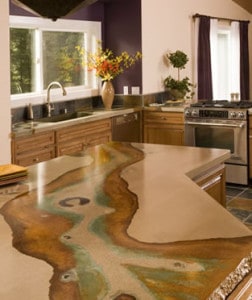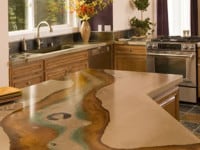
Concrete countertops have been hot for a while and they’re not cooling off. With new colorizing and staining techniques, their appeal is growing, if anything. If you’re not familiar with concrete countertops and what can be done to maximize their beauty, you should learn more about them before making your countertop choice.
This guide will help by pointing out the strengths and weaknesses of concrete countertops. To compare concrete with granite, crushed glass, quartz and slate, see all of our Pros and Cons articles.
Reasons to Consider Concrete Countertops
First of all, concrete countertops can be absolutely beautiful. If you’re picturing laying a piece of sidewalk over your cabinets or work island, you’ve got the wrong mental image. Most homeowners choose pigmented or stained concrete counters that revolutionize their appearance. With pigment, you can have nearly any shade you desire. With staining, you can give your countertops the look of granite or other natural stone. Texturing techniques increase the uniqueness and beauty of the finished product.
Some skilled installers specialize in embedding tile, stone, glass, shells or other materials in the concrete to produce a work of art that is also highly functional and durable.
Concrete, as you know, is extremely hard and tough. It will stand up very well to the wear and tear of a busy kitchen or active family. It won’t scratch and is very heat resistant. These two qualities are essential in kitchens and bathrooms where sharp objects and hot items are common.
Reasons to be Cautious about Concrete Countertops
Concrete countertop prices are high, so this will turn off many homeowners right from the start. When you get estimates, you’ll find prices ranging from $75-$150 per square foot, or possibly higher if you choose an elaborate design.
Secondly, concrete counters require a level of maintenance some won’t want to deal with or have the time for. They must be properly sealed from the beginning and then resealed every 1-3 years. When not sealed correctly, concrete is susceptible to staining, a weakness it shares with granite and marble. Wine, juice, coffee or oil are just a few things that can produce a stain, and all are common in the kitchen.
Summary
If you are comfortable taking a risk, or if you want something one of a kind for your home, take a closer look at concrete countertops. Learn more about staining techniques and what kind of looks can be achieved. On the other hand, if you would prefer counters that require less maintenance or may not cost as much, there are many other quality options to consider.

I just love this kitchen; I just it all the time. Now with more cotuetrnop choices I’ll be even more content. Thanks Sarah for creating and sharing.PS The counters are gorgeous. You did an awesome job with the textures.